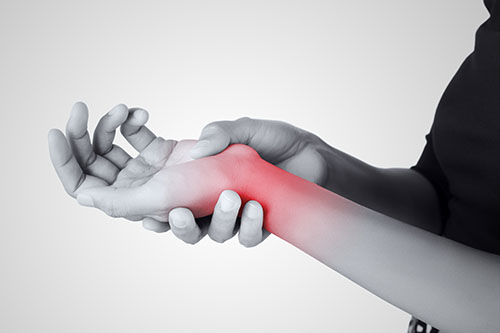What is an Acute Wrist Injury?
14 August 2017
Due to its location and delicate structure, the wrist is one of the body parts that are most prone to injuries and pain. Unlike chronic pain, acute wrist pain is any type of pain that is present for less than two weeks and usually has a very abrupt outbreak, often as a result of trauma.
Acute wrist injuries, especially sprains, strains and breaks, happen all too frequently, which is why here at WristSupports.co.uk we have decided to put together a list of the most common acute wrist injuries and ways to recognise them.

What Classifies as an Acute Wrist Injury?
An acute wrist condition can be defined as pain that is present for less than two weeks and is often caused by a fall onto the hand with an outstretched arm or by a forced twisting motion.
If the pain persists for over two weeks, you may be dealing with a subacute condition, while pain that has been present for longer than three months indicates a chronic injury.
Which Are the Most Common Acute Injuries?
Most acute wrist injuries result from trauma and the damage can occur to bones, ligaments (connecting bone to bone) and tendons (connecting muscle to bone) of the wrist. Below is a list of some of the most common wrist injuries and their symptoms.
- Wrist Strain (Symptoms: gradual or sudden pain, tenderness to the touch, swelling)
- Sprained Wrist (Symptoms: sudden pain, tearing or popping feeling, mild swelling or bruising)
- Triangular Fibrocartilage Complex (TFCC) Tear (Symptoms: pain on the little finger side, tenderness over the back of the wrist, swelling, reduced grip strength, sometimes a clicking sound)
- Broken Wrist (Symptoms: sudden pain, rapid swelling, potential deformation, tingling or numbness)
- Scaphoid Fracture (Symptoms: sudden pain, rapid swelling at the back of the wrist, difficulty gripping, tenderness to the touch)
- Colles Fracture of the Wrist (Symptoms: instant pain, rapid swelling, potentially deformed look)
- Carpal Fracture (Symptoms: sudden pain, rapid swelling, gradual bruising, tenderness to the touch, tingling or numbness)
- Smith's Fracture (Symptoms: instant pain, tenderness, difficulty moving the wrist, sometimes deformed look, immediate swelling and possibly bruising)
- Dislocated Wrist (Symptoms: severe pain with obvious deformity of the wrist, possible tingling in the thumb, index and middle fingers)
- Bennett Fracture (Symptoms: rapid swelling, possible bruising, difficulty moving the wrist and thumb)
- Bruised Wrist (Symptoms: obvious pain on impact, tenderness to the touch, rapid swelling, gradual bruising, reduced range of motion)
- Bartons Fracture (Symptoms: sudden pain, difficulty moving the wrist, rapid swelling, possible gradual bruising, tenderness to the touch over the site of the fracture)
- Triquetrum Fracture (Symptoms: sudden pain on the little finger side of the wrist, rapid swelling, tenderness when pressing in over the fractured area, reduced grip strength and range of motion)
- Distal Radial Epiphysis Injury (Symptoms: pain when bent backwards with the palm facing down, limited mobility, tenderness and swelling around the end of the bone)
- Hook of Hamate Fracture (Symptoms: wrist pain on the little finger side of the wrist, reduced grip strength, tenderness when touching the palm side)
- Distal Radioulnar Joint Subluxation (Symptoms: sudden pain, increased pain when turning the hand over, usually sudden deformation, the wrist may appear narrower, possible swelling and tenderness to the touch)

What Can I Do About It?
In the first 72 hours after the injury, the first aid principles of PRICE are advised:
- Protection: protect the injured area from further injury
- Rest: avoid activity for the first 48 to 72 hours after injury
- Ice: apply cold therapy to the injured area for the first 48 to 72 hours
- Compression: compress the injured area to limit any swelling and movement
- Elevation: keep the injured wrist raised and supported on a pillow
If the pain persists or gets worse, it is advised to seek medical advice.
Most minor injuries, however, can be treated by keeping the wrist immobilised and protected with the help of a wrist support. Check out our broad selection of Wrist Supports for Acute Injury.
Do you have a question to ask or something to add? Why not leave us a comment below or find us on Facebook or Twitter.


